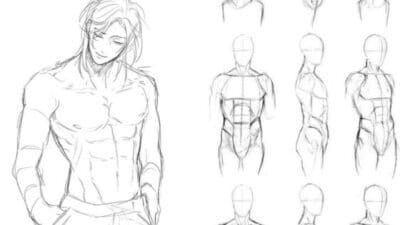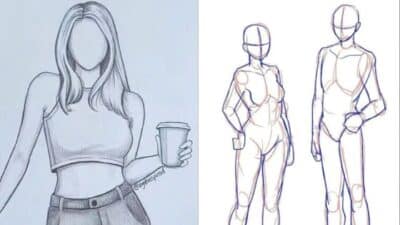Drawing the human body can seem intimidating, but every artist starts somewhere. This body drawing tutorial offers clear, step-by-step guidance to help artists, both new and experienced, draw human figures with confidence. With a focus on essential techniques and proportions, this resource aims to simplify the process and make figure drawing accessible to everyone.


The journey of learning to draw bodies involves grasping the basics of anatomy and mastering proportions. Each tutorial will share insights and tips that will enhance drawing skills and techniques. As artists practice, they will begin to understand the fluidity of movement and the unique characteristics of the human form.
By engaging with this tutorial, artists will not only learn to draw bodies more accurately but also develop their own style and expression. This guide will be an essential tool for anyone interested in improving their figure drawing abilities.
Key Takeaways
- Understanding body proportions is key to accurate drawing.
- Regular practice helps artists develop their unique styles.
- Clear techniques can make figure drawing easier for everyone.
Understanding the Basics

To draw the human body effectively, a strong grasp of human anatomy, proportions, and the right materials is essential. These elements work together to help a beginner create accurate and appealing body drawings.
Introduction to Human Anatomy


Basic human anatomy provides the foundation for body drawing. Understanding the body’s structure allows for more realistic representations.
Anatomy involves learning about key parts:
- Bones: The skeleton gives shape and support.
- Muscles: Knowing muscle groups helps show movement and form.
- Joints: Understanding how joints work will improve flexibility in drawings.
Artists can start by referencing anatomical diagrams. Observing real bodies can help too. Beginners should practice drawing each part separately before connecting them.
The Role of Proportions in Body Drawing


Proportions are vital in creating accurate figures. They determine how body parts relate in size and placement.
One common method divides the body into sections. For adults, the body is roughly 8 heads tall. Key proportions include:
- Shoulder width: About 2 heads wide.
- Waist: Typically less than shoulder width.
- Legs: Often longer than the torso.
Using a ruler or grid can help maintain correct proportions. Beginners may also benefit from sketching light guidelines to set boundaries for body parts.
Essential Drawing Materials
Having the right tools makes drawing easier. Here are key materials beginners should consider:
- Pencils: Various hardness levels for different shading.
- Erasers: Kneaded and hard erasers for corrections.
- Paper: Smooth paper works well for detailed drawings.
- Reference Images: Collect photos or anatomical references for guidance.
Using quality materials can improve the drawing experience. Each tool plays a role in enhancing skills and achieving desired results.
Getting Started with Figure Drawing

Starting figure drawing involves key steps like observation and practice. These methods help build a strong foundation for any artist. Focusing on basic forms and techniques allows for better understanding of human anatomy and movement.
Observation Techniques


Observation is vital in figure drawing. Artists should learn to see the human body with fresh eyes. It helps to notice shapes, lines, and proportions.
Using reference images or live models can be very effective. Take time to study the model’s pose carefully. Artists should observe the angles and curves. This practice improves the ability to capture the essence of movement.
To enhance observation skills:
- Draw regularly: Setting aside time for daily sketches helps improve accuracy.
- Use grids: They assist in breaking down complex forms into manageable parts.
- Analyze anatomy: Knowing the basic structure of bones and muscles aids in representation.
Warm-Up Exercises: Gesture and Stick Figures
Warm-up exercises prepare artists for drawing. Gesture drawing is a quick way to capture a model’s movement. This technique involves sketching the figure in a few minutes.


Using stick figures is a helpful starting point. Begin by drawing simple lines to represent the main joints: shoulders, elbows, hips, and knees. Once the stick figure looks right, add basic shapes to form the body.
Practicing these exercises can:
- Improve speed in drawing.
- Enhance confidence in capturing movement.
- Help focus on proportions and balance.
Both gesture drawing and stick figures lay the groundwork for more detailed work later.
Mastering Proportions and Measurements

Understanding proportions and measurements is key to creating accurate body drawings. This section explores how to use the head as a measurement unit, apply these measurements when drawing people of different ages, and tackle issues related to distortion and perspective.
Using the Head as a Unit of Measurement
The head serves as a standard unit in figure drawing, commonly dividing the body into proportional sections.
Basic Structure: An average adult figure is roughly 8 heads tall. Each head can represent different body parts:
- Head: 1 unit
- Shoulders: 2 heads wide
- Hips: 2 heads wide
Children’s Proportions: Children appear shorter, usually measuring around 5-6 heads tall. Their heads are larger compared to their body, which gives them a distinct look.
By using heads to measure, artists can ensure that body parts relate correctly to each other, maintaining harmony in their drawings.
Applying Measurements to Drawing Children and Adults

When drawing adults, artists should focus on maintaining realistic proportions. Adult figures often follow the 8-head guideline. Each section helps figure placement and scale.
For children, the proportions shift significantly:
- Ages 0-2: About 4 heads tall, with oversized heads.
- Ages 3-7: Roughly 5 heads tall. The head is still large but begins to shrink comparatively.
Artists should pay attention to these differences to avoid mismatched proportions and capture the essence of age.
Dealing with Distortion and Perspective


Distortion occurs when angles or shapes appear different due to perspective. Understanding how to handle this is essential for accurate drawings.
Foreshortening: This technique shortens the appearance of limbs or body parts as they recede into space. It can alter measurements to maintain proportion.
Position and Angle: A figure viewed from above or below will change how proportions appear. Observing varying angles helps artists adapt their measurements effectively.
Practice: Regular practice with real-life subjects aids in recognizing and correcting distortions.
Paying attention to these factors creates more realistic and engaging figures in art.
Developing Your Drawing Techniques

Improving drawing skills involves mastering contour, shading, and rendering facial features. These fundamental techniques help artists create more realistic and accurate drawings of the human body.
The Art of Contour and Line Drawing


Contour drawing focuses on the outlines of figures. Artists create contour lines that define the shape of the body. This technique helps in understanding the structure and form.
To practice, start with simple shapes. Focus on drawing the contours without lifting the pencil off the paper. This develops hand coordination and visual observation.
Using different line weights can enhance depth. Thicker lines can emphasize the outline, while thinner lines can show details. This contrast adds interest and dimension to the drawing.
Introduction to Shading and Texture


Shading brings drawings to life by adding depth and volume. To begin, choose a light source to determine where shadows fall.
Techniques for shading include hatching, cross-hatching, and blending. Hatching uses parallel lines, while cross-hatching layers lines in different directions. Blending involves smoothing out the shading for a softer look.
Textures are crucial in depicting various surfaces. For example, smooth skin looks different from rough clothing. Artists can experiment with different pencils to achieve varied textures.
Techniques for Rendering Facial Features
Facial features add character and emotion to figure drawings. Start with basic shapes for the head and neck.
Key features include eyes, nose, mouth, and ears. It’s important to focus on proportions, as they vary between individuals.
For eyes, understanding the eyelid and pupil placement is essential. Noses can be drawn by understanding their structure and angle. Practice different mouth shapes to show expression.
Regular practice and observation of real faces will improve skill. Using reference images can also help in getting details right.
Enhancing Your Figure Drawing Skills


Improving figure drawing skills involves exploring various techniques. Key areas include learning to capture motion and using perspective effectively.
Exploring Gestural Drawing
Gestural drawing focuses on capturing the essence and movement of a figure quickly. Artists use loose, flowing lines to express dynamic poses. This technique helps develop a sense of action and proportion without getting bogged down in details.
To practice, artists can:
- Set a timer: Allocate 1-5 minutes per sketch to focus on swift movements.
- Use continuous lines: Draw without lifting the pencil to maintain flow.
- Focus on rhythm: Pay attention to how the torso and limbs interact.
These exercises encourage spontaneity and strengthen observation skills.
Studying the Dynamics of Human Movements


Understanding human movements is crucial for realistic figure drawing. Artists should study anatomy and how muscles affect movement. Observing live subjects, like dancers or athletes, provides insights into how the body works in different poses.
Key points to observe include:
- Balance and weight distribution: Notice how weight shifts in various poses.
- Joint angles: Examine how joints bend and rotate during movement.
- Muscle tension: Identify how muscles engage during different activities.
By analyzing these dynamics, artists can create more lifelike representations.
Foreshortening and Depicting Angles
Foreshortening is a technique that creates depth in drawings by shortening the appearance of body parts closer to the viewer. Mastering this skill makes figures look more three-dimensional.
To practice foreshortening:
- Draw from references: Use photographs or live models to see how angles change.
- Focus on overlapping: Show how parts of the body cover others to establish depth.
- Use guidelines: Create simple shapes to understand proportions before adding details.
Mastering these techniques allows artists to depict angles accurately, enhancing the overall impact of their drawings.
Digital Drawing and Character Design

Digital drawing allows artists to create vibrant character designs and complex human figures with ease. This section explores important aspects of transitioning from traditional art, constructing the human body, and maintaining consistency in character designs.
Transitioning from Traditional to Digital


Artists starting digital drawing can find it different from traditional methods. Key tools like drawing tablets and software programs can change how an artist works.
- Familiarize with Tools: Learn to use a stylus and tablet, which mimic pencil and paper.
- Explore Software: Programs like Procreate or Photoshop offer many brushes and layers.
- Practice Techniques: Start with simple sketches. Gradually try adding colors and shadows.
Taking time to explore these tools can help ease the transition and enhance drawing skills.
Constructing the Human Figure in Digital Media


Understanding the human figure is essential to character design. Digital artists can break down body drawing into simpler shapes and proportions.
- Basic Shapes: Start with circles and rectangles to outline the body.
- Proportions: Study proportions. For example, the average human figure is about 8 heads tall.
- Practice Anatomy: Resources like online tutorials can guide artists in drawing male and female figures.
By mastering these fundamentals, artists can create more realistic and appealing characters.
Creating Consistent Character Designs


Consistency in character design is vital for storytelling. It helps develop a character’s identity and makes them relatable.
- Design Sheets: Create character sheets that showcase different poses and expressions.
- Color Palette: Choose a consistent color scheme. This adds unity to all character designs.
- Style Guide: Document key characteristics, such as height and outfit details. This can help maintain consistency.
These practices ensure that characters remain recognizable and engaging throughout any artwork or story.
Drawing Techniques and Styles
Different drawing techniques and styles can greatly improve a person’s body drawing skills. By understanding various methods, artists can find what works best for them and express their creativity effectively.
From Realism to Stylization


Realism focuses on capturing human anatomy as accurately as possible. This style requires a solid understanding of proportions and body structure. Artists study real-life bodies and practice drawing from observation.
Stylization, on the other hand, allows for more creativity. Artists may exaggerate certain features or use unique proportions to express their ideas. This approach can lead to interesting and personal artwork.
Each artist can choose a style that suits their vision. They can also blend both realism and stylization to create a hybrid approach, bringing together the best of both worlds.
Incorporating Geometric Shapes into Figure Drawing


Using geometric shapes is an effective method in figure drawing. Artists often start by sketching basic shapes like circles, squares, and triangles to create a framework.
These shapes simplify the process of drawing the human form. For example, the head can begin as a circle, while the torso may be represented by a rectangle. This helps maintain correct proportions.
Once the basic shapes are in place, artists can refine the drawing by adding details and curves. This practice makes it easier to capture movement and poses accurately. It also aids beginners in building confidence in their skills.
Developing Your Unique Style
Finding a unique drawing style is a personal journey for every artist. It often involves experimenting with different techniques and influences. Artists should explore various styles, from cartoonish to realistic, to see what resonates with them.
Keeping a sketchbook for practice can also help refine individual styles. Artists can regularly doodle and try new ideas without the pressure of perfection. This encourages growth and discovery.
Over time, artists will naturally develop a style that reflects their personality and vision. By practicing consistently and remaining open to change, their unique approach will shine through in their body drawings.
Practice Makes Perfect


Improving body drawing skills takes time and commitment. Practicing through structured projects and regular sessions helps build solid foundations.
Step by Step Projects
Step by step projects break down complex body drawing tasks into smaller, manageable parts. Each project allows the artist to focus on specific body parts, such as the torso, arms, or legs.
For example, an artist might start with sketching basic shapes to create a rough outline. Then, they can refine the details like muscle structure and proportions. These projects help develop confidence as they track progress with each completed piece.
Using tutorials can also guide artists through various techniques. They can find resources online and use video lessons to see the drawing process in action. This method encourages learning and improvement through practical application.
Regular Sketching and Life Drawing Sessions
Regular sketching plays a vital role in honing body drawing skills. Consistency helps artists retain techniques and improve their speed. Setting aside time for daily sketches can keep skills sharp.
Life drawing sessions, where artists draw from live models, offer a unique experience. Observing real people enhances understanding of body movement and anatomy. Artists learn how to capture poses and gestures in different angles and perspectives.
Joining a drawing group can provide motivation and feedback. Engaging with other artists creates opportunities for shared learning and support. Both sketching and life drawing nurture creativity and build lasting skills.
Tips for Continuous Improvement


To continuously improve body drawing skills, artists should seek feedback. Sharing work with friends or online communities invites constructive criticism. This feedback helps identify areas for growth and new techniques to explore.
Setting specific goals can also guide an artist’s practice. For instance, aiming to master drawing the female body in different poses can focus efforts. Tracking progress over time allows artists to celebrate small wins.
Using a variety of resources is essential. Books, online tutorials, and video lessons all offer different insights. Experimenting with new styles and techniques keeps the learning journey fresh and exciting.
- 8.0Kshares
- Facebook0
- Pinterest8.0K
- Twitter0



